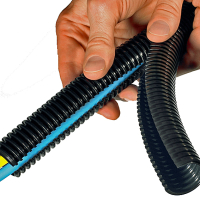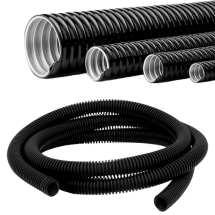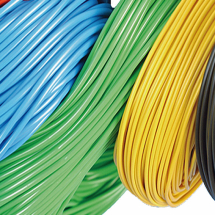Cable Protection – Conduit & Sleeving Solutions
Cable protection can be split into two main groups: conduit, which protects cables outside enclosures, and sleeving, used inside assemblies. Whether you need mechanical strength, temperature resistance, or abrasion protection, we offer solutions including conduit, PTFE / silicone sleeving, heat-shrink and more.
1. Conduit Systems
Conduit is designed to protect cables outside electrical cabinets or enclosures. Features include excellent mechanical strength, flexibility, and resistance to environmental stresses.
- Heavy-duty materials for external protection
- Terminated with fittings for enclosures or panel entries
- Flexibility to bend without damage, yet robust against impacts
- Wide temperature range capability depending on material
2. Sleeving & Internal Protection
Sleeving is primarily used within assemblies to control, group or protect cables. High performance materials are used where insulation, temperature or abrasion are factors.
- PTFE and silicone sleeving for high temperature / chemical resistance
- Heat-shrink sleeving for tight, insulated protection
- Flexible sleeving for harnessing or bundling internal wiring
- Options for electrical insulation, moisture and abrasion protection
3. Material & Environmental Considerations
Selecting the right protection depends heavily on environment and application demands. Consider these when choosing your components:
- Temperature range both for continuous and peak conditions
- UV, moisture and chemical exposure
- Abrasion resistance and mechanical stress (e.g. vibration or external impacts)
- Flexibility vs. rigid protection based on installation constraints
4. Common Protection Products We Stock
Our selection includes a variety of protection solutions suited for many use cases:
- Rigid and flexible conduit systems
- Sleeving in PTFE, silicone, and high-performance polymers
- Heat-shrink tubing for insulating / grouping wires
- Protection plates, grommets or fittings for entry points
5. Making the Right Choice & Installation Tips
- Ensure terminations and fittings properly support conduit to avoid cable strain
- Match sleeving OD (outer diameter) to cable size for fit and thermal performance
- Avoid sharp edges or bends inside conduit or sleeves which can damage insulation
- Use protective ends, caps, or conduit bushings where appropriate
- Check compatibility with existing wiring, thermal environment and mechanical stressors



